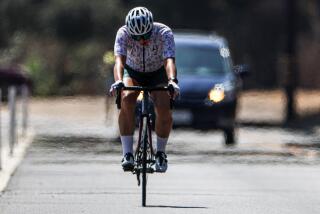Record-breaking heat wave will broil Southern California for a few more days

The record-breaking heat wave pummeling Southern California will continue through the weekend, delivering a miserable combination of triple-digit highs and unrelenting overnight heat.
The National Weather Service in Oxnard said Saturday morning that “dangerously hot conditions” will continue in the region through Monday. On Saturday, temperatures were expected to be 2 to 10 degrees lower than Friday’s record-breaking heat, meteorologists said, but still hovering 15 to 25 degrees above normal. They will climb again Sunday.
“This is about the most significant heat wave we’ve had in the metro area for several years,” said John Dumas, another meteorologist with the National Weather Service in Oxnard.
There is light at the end of the tunnel: Much cooler temperatures are expected to arrive on Tuesday and last through the end of next week. An upper-level trough of low pressure will move into the area, allowing more onshore flows of cool ocean breezes, said Joe Sirard, another National Weather Service meteorologist in Oxnard.
Friday’s temperatures shattered five daily records in Los Angeles and Orange counties set in the summer of 2020. A reading of 102 at Los Angeles International Airport broke the 2020 record of 99 degrees, and 109 degrees at Long Beach Airport surpassed the 2020 record of 104. A temperature of 114 degrees at Burbank Airport marked an all-time high since the weather service began keeping records in 1939.
On Saturday, daily records were set by temperatures reaching 101 at Long Beach Airport, 111 at Woodland Hills and 95 at Camarillo. Elsewhere in Southern California, some cloud cover Saturday helped keep temperatures down, Dumas said, but overcast conditions at night will prevent the region from cooling off and the mercury will rise again Sunday.
“Don’t let down your guard,” Sirard said. “Stay out of the heat and drink plenty of liquids. Go to the theater or mall; go get ice cream. It’s too dangerous to hike.”
As the temperature neared 100 degrees in downtown Los Angeles on Saturday, kids zipped around the splash pad in Gloria Molina Grand Park.
For the record:
11:07 a.m. Sept. 8, 2024An earlier version of this article incorrectly quoted Elaine Lagunas as saying her students have been fussier because their classrooms were not equipped to deal with 100-degree afternoons. She said it can get hot at her school but the school’s air conditioning has worked amid the heat wave.
“It’s intolerable,” said Elaine Lagunas of Covina, a teacher, who said the heat had caused her 6-year-old daughter to complain of a stomachache a few days before.
She said it can get hot at her school as teachers are forced to contend with 100-degree afternoons. But she noted her school has air-conditioning units, which have worked throughout the heat wave.
Saturday brought humidity as well as heat. A few showers hit the eastern San Gabriel Mountains and eastern Antelope Valley Mountains, but there were no thunderstorms, as had been forecast. Thunderstorms did bring lightning, thunder and heavy rain over mountains in the counties of San Bernardino, Riverside and San Diego. By 6:30 p.m. Saturday, 282 lightning strikes were recorded in Highland and Big Bear with 3,337 other lightning flashes that stayed in the clouds, the National Weather Service in San Diego reported.

Meteorologists said outflow winds around the thunderstorms may have exacerbated an uncontrolled wildfire in San Bernardino County, which forced thousands of residents to evacuate the mountain communities of Running Springs, Arrowbear Lake and other areas. Images from a live video feed posted on social media showed a long line of cars slowing moving down a single mountain lane.
The Line fire doubled in size early Saturday from 3,800 acres in the city of Highland to 7,122 acres by the evening as it spread northeast toward Running Springs and Arrowbear Lake. Steep terrain and lack of access impaired the ability of crews to access some areas of the fires, the California Department of Forestry and Fire Protection said in a statement.
Five hundred firefighters were using hand lines, hoses and fixed-wing aircraft to fight the blaze, which was 0% contained as of Saturday night.
The extreme heat also left thousands of households without power across Southern California.
Southern California Edison said that as many as 8,600 households in Los Angeles County, and nearly 1,600 in San Bernardino County, had lost power Saturday.
The Los Angeles Department of Water and Power also reported outages affecting thousands of households across the eastern and northern swaths of its coverage area Saturday morning, including Silver Lake, Exposition Park, University Park, Mission Hills, Sylmar, Pacoima and Arleta.
Los Angeles Mayor Karen Bass said the LADWP was working around the clock with extra staff to repair equipment and restore power. More than 7,000 LADWP customers were without power at noon Saturday, the city said.
Los Angeles libraries and park buildings are open for people who need relief from the heat, Bass said. The city also has a half-dozen “augmented cooling centers,” which offer charging stations and refrigeration for medications.
“We will continue to urgently provide resources for Angelenos throughout Los Angeles in order to beat the heat,” Bass said.
In Torrance on Saturday afternoon, traffic slowed to a crawl at Hawthorne Boulevard and Carson Street, where traffic lights had gone out. The power was also out in portions of Del Amo Mall, including the Macy’s department store.
The California Independent System Operator, which manages the state’s energy grid, said there was enough power statewide to meet demand.
Marcos Gutieres, 47, sought refuge from the heat under a tree in Elysian Park with his brother Saturday afternoon.
Gutieres tries to avoid turning on the air conditioning in his apartment near downtown L.A. He spent about $250 cooling the place in July and $350 in August, he said, and is nervous about this month’s bill.
At his job lifting pallets in a warehouse, he tries not to stray too far from the portable fans, he said.
Jose and Angela Suarez also try not to turn on the air conditioning at home in Long Beach.
Angela Suarez said the cost of cooling their home has nearly doubled this summer. If it’s below 80 degrees outside, she said, they leave the A/C off.
The Suarezes have left home less frequently this summer because of the heat. On Saturday, they made an exception for a particularly sweaty R&B concert in downtown Los Angeles.
And when they return home, they’ll crank up the A/C.
“On a day like this, you have to eat the cost,” said Angela Suarez, 37, waving herself with a patterned fan.
Times staff writer Teresa Watanabe contributed to this report.
More to Read
Sign up for Essential California
The most important California stories and recommendations in your inbox every morning.
You may occasionally receive promotional content from the Los Angeles Times.











